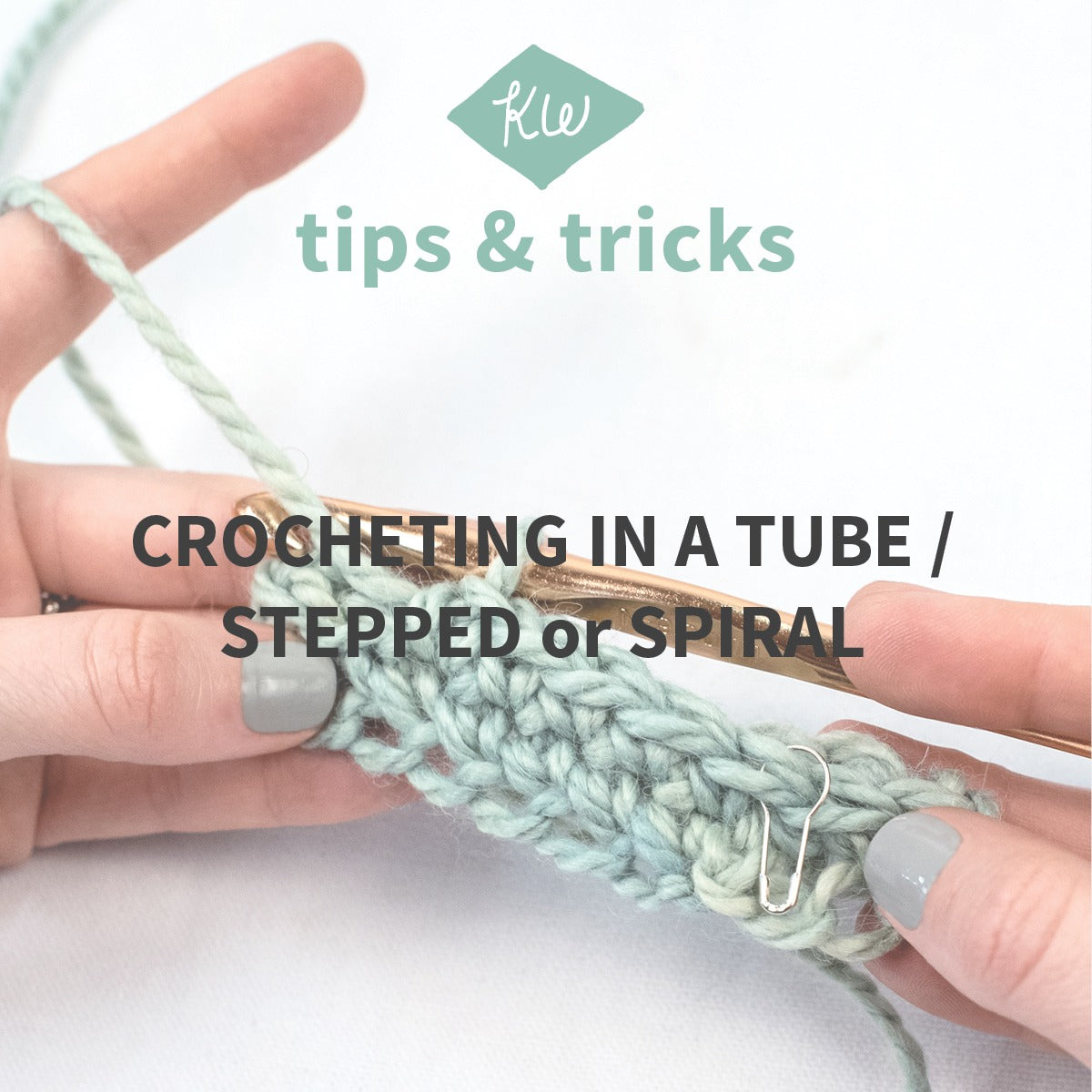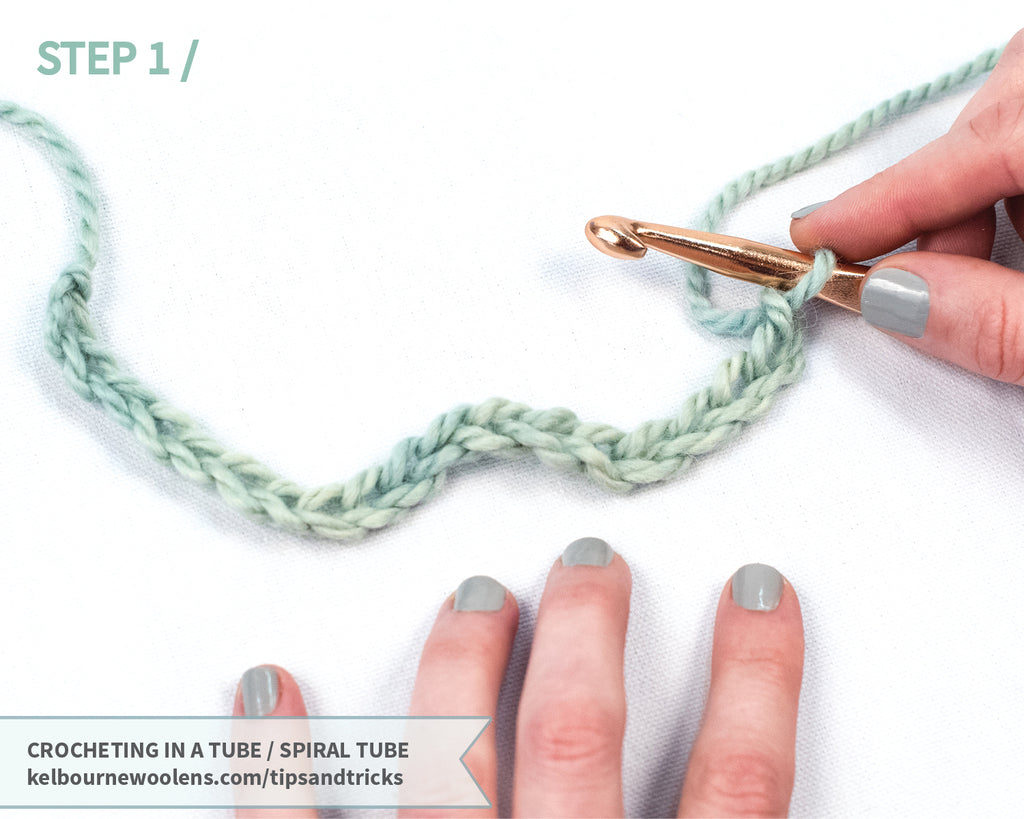Crocheting in a Tube: Two Ways
Crocheting in the round – as in the case of granny squares – tends to be an easy and straightforward skill to learn. Crocheting in a tube, on the other hand, is a little bit more complicated, as maintaining proper stitch count requires a bit more skill and attention.
There are two common methods to crocheting in a tube. The first method is a
stepped tube, where each round is worked as an individual section. The next round is then “stepped up” using chain stitches and worked as another individual section. The second method is the
spiral tube, which is worked in the same manner as knitting in the round.
There are pros and cons to each method. The best bet is for you to practice both with a basic stitch you are comfortable with to see which one you prefer. If you don’t have a preference, many times, patterns will also tell you which method to use depending on the end result the designer has in mind.
Method One: Stepped Tube
Step 1 / Slip knot onto your hook. Crochet however many chains your pattern calls for. In my sample, I’ve done 20 chains. Remember to not count the chain on your hook.
Step 2 / Carefully make sure all Vs of the chain are facing the same way. (If you’re familiar with joining knitting in the round, this is the same concept as “being careful not to twist stitches”.) Place your hook into the first chain. Work a Slip Stitch, (yo, pull through loop on chain, then loop on hook). Your chain is now connected into a tube.
Step 3 / Chain the required number of stitches to work the stitch pattern you are using, just as if you were working back and forth. (Here we’re doing single crochet, so I am working a ch 1.) This chain counts as a stitch.
Step 4 / Crochet into each stitch around, making sure you have the same number of stitches as you originally chained. Do not forget that you are counting the chain(s) from Step 3 as your first stitch.
Note: I’m crocheting into the back loop for this round, which can sometimes make the chain stitches appear a little loose, especially in the case of a larger gauge yarn.
Step 5 / To complete the round, work a slip stitch into the top of the chain at the beginning of the round.
Step 6 / To work a second and all subsequent rounds, repeat Steps 3-5 for your desired length.
This method is useful if the back side of your work will be hidden, as the “steps” create a clear vertical line up your work. It is beneficial, though, as it makes it very easy to maintain proper stitch count as each round is its own unique process with a defined beginning and end. The above images shows a tube with 7 rounds completed with the seam hidden in the back, and then with the seam front and center.
Method Two: Spiral Tube
Steps 1 and 2 of the Spiral Tube are the same as the Stepped Tube:
Step 1 / Slip knot onto your hook. Crochet however many chains your pattern calls for. In my sample, I’ve done 20 chains. Remember to not count the chain on your hook.
Step 2 / Carefully make sure all Vs of the chain are facing the same way. (If you’re familiar with joining knitting in the round, this is the same concept as “being careful not to twist stitches”.) Place your hook into the first chain. Work a Slip Stitch, (yo, pull through loop on chain, then loop on hook). Your chain is now connected into a tube.
Step 3 / Chain 1, then work 1 single crochet into the same space as the slipped stitch. Note: This step is only worked at the very beginning of your piece.
Step 3a / You may find it helpful to place a marker here identifying the first stitch in the round. It can be very useful when counting back to make sure you have worked the correct number of stitches in each round.
Step 4 / You may find it helpful to place a marker here identifying the first stitch in the round. It can be very useful when counting back to make sure you have worked the correct number of stitches in each round. Single crochet in each of the remaining chain stitches. Note: As with the Stepped Tube, I am crocheting in to the back loop for the first round.
Step 5 / Once you reach the marker placed in the previous step, remove the marker. Work a single crochet into the marked stitch, then replace the marker into the stitch you just worked. Single crochet into each of the previous single crochets until you reach the end of the round.
The above images show a tube with 7 rounds completed with the seam hidden in the back and the front. If you look closely, you’ll notice the start of each round is moving to the right at a slight angle.
As with knitting in the round, when using the spiral technique you’re simply creating a concentric circle of crochet stitches, much like building a coil pot. Unlike knitting, since there are no live stitches on your hook, it can be easy to gain or lose stitches, which is why we recommend placing the marker at the first stitch of every round so you can make sure you always have the correct number of stitches until you’re really comfortable “reading” your work.

















